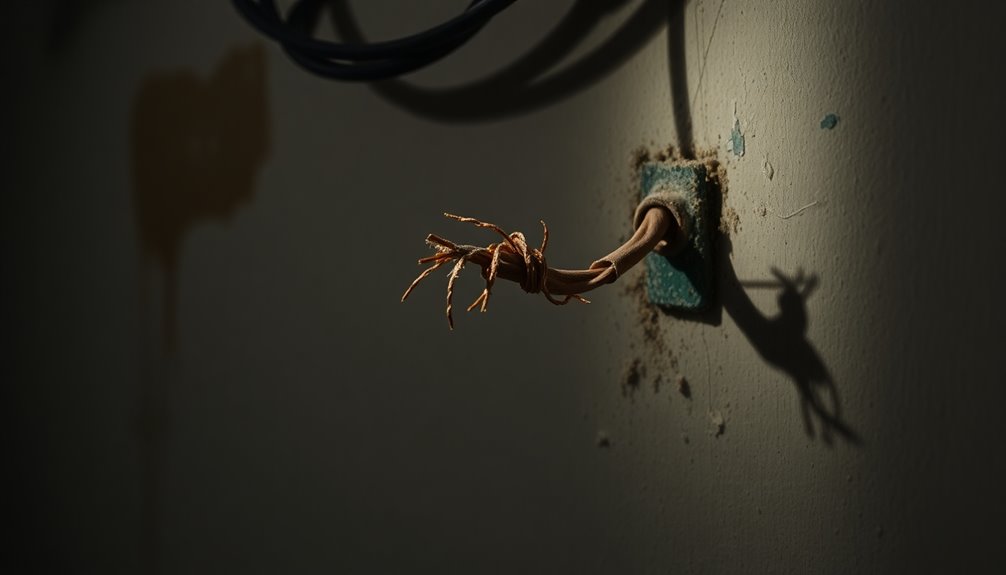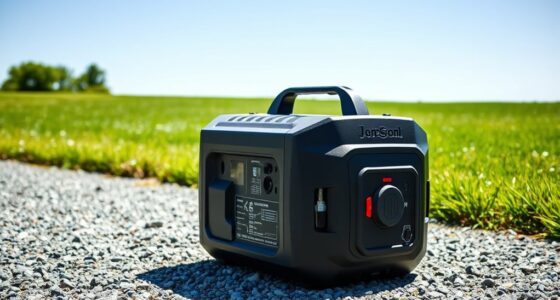Frayed wires are more than just an eyesore; they're a serious electrical hazard. When insulation wears away, exposed metal can lead to electrocution or fire. Common causes include rodent damage, excessive bending, and moisture. You might notice flickering lights, unusual heat from outlets, and strange buzzing sounds—a sign that danger lurks nearby. Ignoring these signs amplifies the risks, with thousands of house fires attributed to electrical faults each year. It's essential to inspect your wiring regularly and take immediate action if fraying is detected. To guarantee you stay safe, there's much more you should know about this hidden danger.
Key Takeaways
- Frayed wires indicate deteriorating insulation, exposing conductive metal, which can lead to serious electrical hazards and fires.
- Common causes of frayed wires include rodent damage, friction, moisture, and excessive bending, often found in high-traffic areas.
- Signs of frayed wiring include flickering lights, burning smells, and unusual heat from outlets, indicating potential danger.
- Ignoring frayed wiring increases the risk of electrocution and electrical fires, with approximately 3,000 house fires caused by electrical faults annually.
- Regular inspections and prompt repairs are essential to prevent hazards associated with frayed wiring and ensure electrical safety.
Understanding Frayed Wires
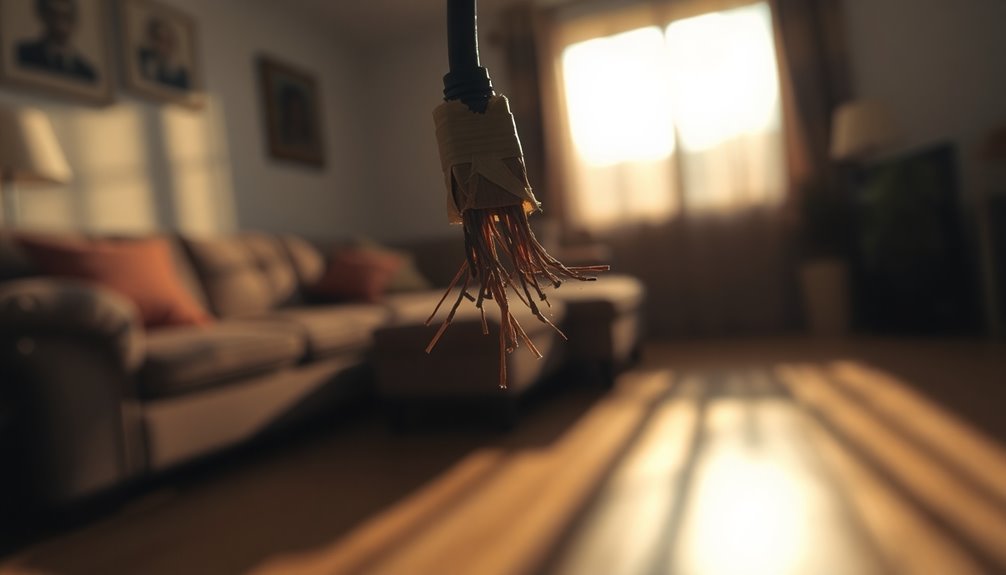
When you come across frayed wires, it's vital to understand what they signify for your safety. Frayed wires indicate that the insulation around electrical wiring is deteriorating, exposing conductive metal and increasing the risk of electrical hazards. This deterioration can stem from various factors like rodent damage, surface friction against sharp edges, excessive bending, and environmental influences such as moisture or heat.
You should be vigilant and know the signs to look for—flickering lights, unusual heat from outlets, persistent buzzing sounds, and visible damage to cords and insulation may all signal damaged wiring. Ignoring these signs can lead to severe consequences, including potential electrical fires, electrocution hazards, and significant property damage.
To maintain safety in your home, prioritize regular inspections and maintenance of your electrical systems. Catching frayed wires early allows you to replace them before they escalate into dangerous situations.
Identifying Signs of Damage
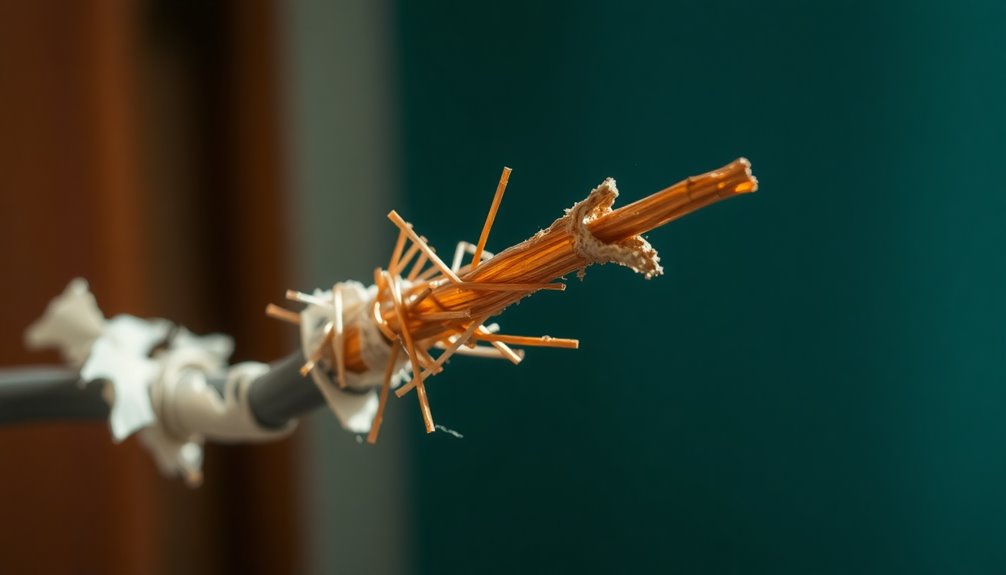
Recognizing the signs of damage in electrical wiring is essential for ensuring safety in your home. Ignoring these indicators can lead to serious risks, such as fire hazards.
Here are three key signs to watch out for:
- Visible Damage: Look for frayed wiring, damaged insulation, or exposed metal strands. These physical signs can indicate a severe electrical hazard.
- Overheating: If you notice hot switchplates or outlet covers, it's a critical warning sign. Overheating wires can pose a significant fire risk, and you should address this immediately.
- Flickering Lights and Odd Smells: Flickering lights that persist even after replacing bulbs may suggest frayed wiring issues. Additionally, any burning plastic smell near power points or switches is a clear sign of trouble.
Conducting regular inspections of outlets, switches, and junction boxes helps in identifying signs of wear in high-traffic areas.
By being vigilant and recognizing these signs early, you can prevent dangerous situations caused by frayed wiring.
Don't hesitate to seek professional help if you notice any of these warning signs!
Common Causes of Fraying
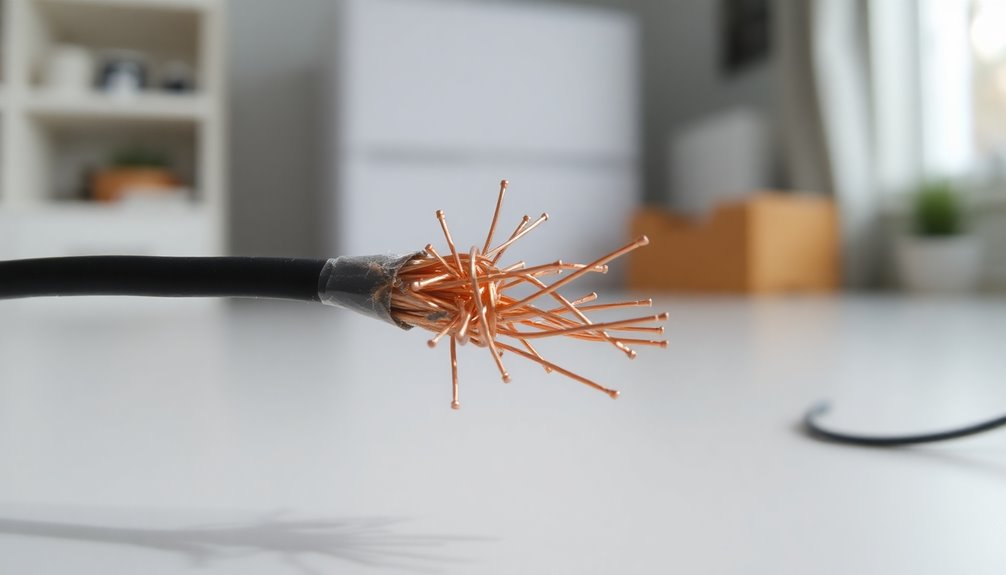
You might be surprised to learn how many factors can cause wire fraying in your home.
Rodent damage, environmental wear, and poor installation practices all play a significant role in this issue.
Understanding these common causes can help you take preventive measures to protect your wiring.
Rodent Damage Impact
Rodent damage greatly impacts the integrity of electrical wiring, as these pests are notorious for gnawing on insulation. This behavior exposes the wires beneath, leading to frayed wiring and significant electrical hazards.
Studies show that around 25% of house fires result from electrical faults, including those caused by damaged wires from rodent infestations.
To safeguard your home, consider the following steps:
- Regular Inspections: Routinely check your wiring for signs of gnawing or wear. Early detection can prevent serious hazards and costly repairs.
- Effective Control Measures: Seal any entry points in your home and maintain cleanliness to deter rodents from making themselves at home.
- Repairing Wiring: If you find any frayed wiring, don't hesitate to address it. Repairing wiring can save you from potential house fires and expensive repair bills, which can range from $100 to $1,000, depending on the damage. Additionally, awareness of emotional manipulation can help prevent situations where neglecting maintenance leads to unsafe conditions in your home.
Environmental Wear Factors
Many factors in the environment can contribute to the fraying of electrical wires. Moisture exposure is one of the biggest culprits, as it leads to the degradation of wire insulation over time. When insulation breaks down, it increases the risk of wires becoming frayed and unsafe.
Extreme temperatures, whether scorching hot or freezing cold, can also cause wiring materials to expand and contract, creating cracks that pave the way for further wear and tear.
Additionally, chemicals from cleaning products or industrial substances can corrode wire insulation, weakening it and exposing the underlying conductors. In high-traffic areas, continuous bending or flexing of wires can lead to surface wear, especially where wires rub against sharp edges. This wear can greatly increase the likelihood of fraying.
Finally, don't overlook the impact of rodent activity. When rodents chew on wires, they damage the protective insulation, exposing the conductive materials and resulting in frayed wires.
Poor Installation Practices
Poor installation practices often set the stage for frayed wires and electrical hazards. When wires aren't properly secured, they can experience undue stress, leading to fraying over time. This not only compromises the wire's integrity but also poses considerable safety risks.
Here are some common causes of fraying due to poor installation:
- Inadequate Protective Coverings: Without proper coverings, wires can scrape against sharp edges, leading to insulation damage and exposing live wires.
- Improper Securing: If wires are over-tightened or poorly anchored, they can wear and fatigue, creating frayed wires that increase the risk of electrical hazards.
- High-Traffic Areas: Installing wires in locations with frequent movement can cause repeated bending, considerably contributing to wear and fraying.
Ignoring these installation guidelines not only violates occupational health and safety standards but also heightens the risk of fire hazards and electrocution.
To safeguard your home, verify that installation practices adhere to electrical codes, utilize protective coverings, and secure wires properly.
Dangers of Frayed Wiring
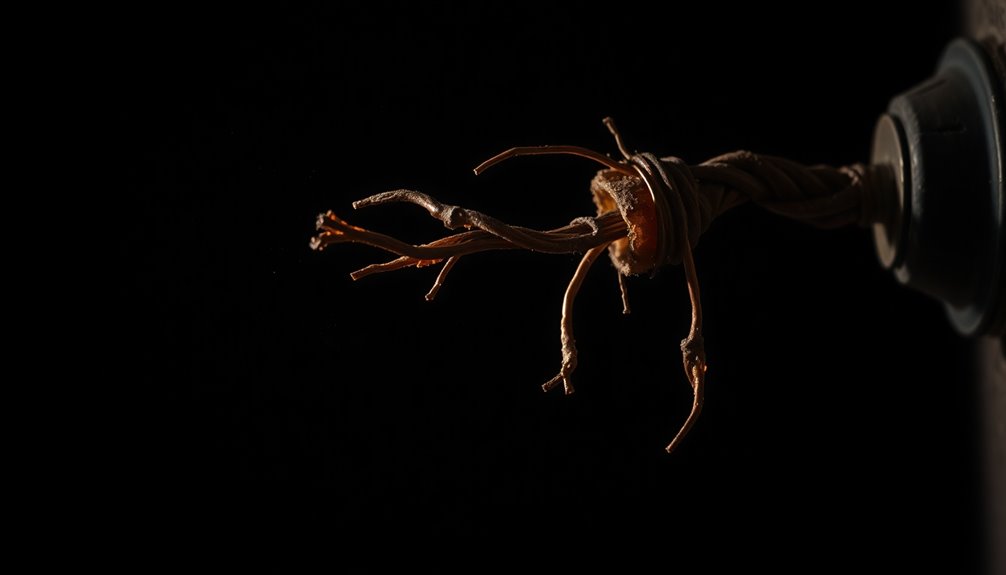
When you encounter frayed wiring, you're not just dealing with an unsightly issue; you're facing serious dangers.
Exposed wires can lead to electrocution, putting you and others at risk of severe injury or worse.
Additionally, the potential for fire hazards makes it essential to address frayed wires immediately to prevent devastating consequences.
Electrocution Risks
Exposing yourself to frayed wiring can be incredibly dangerous, as it considerably heightens the risk of electrocution. Frayed and exposed wires create an open pathway for electrical currents, putting anyone who touches them in jeopardy.
You need to be aware of the following dangers:
- Increased Electrical Shock Injuries: Loose or damaged electrical wiring can lead to severe injuries or even death. Thousands of people end up in emergency rooms each year due to electrical shocks from frayed wires.
- Hazardous Environments: Moisture amplifies conductivity, making damp areas extremely dangerous. Frayed wires in these conditions can quickly lead to fatal accidents.
- Neglected Safety Standards: Regular inspections are essential. Ignoring damaged electrical wiring not only violates safety standards but greatly increases the likelihood of electrocution.
To reduce the risk of electrocution, prioritize routine checks on your power supply and replace any frayed wiring immediately.
Fire Hazards
The dangers of frayed wiring extend beyond electrocution; they considerably heighten the risk of electrical fires. Each year, approximately 3,000 house fires occur in Victoria due to electrical faults, showcasing just how severe these fire hazards can be. Loose currents from exposed wires can easily ignite nearby materials, leading to devastating fires that spread rapidly throughout your home or business.
According to the National Fire Protection Association (NFPA), electrical failures or malfunctions are a leading cause of home structure fires. If you ignore frayed wiring, you're not just risking your safety; you're also endangering your property.
Insulation damage often accompanies frayed wires, leading to overheating, which creates a significant fire hazard if left unaddressed. Additionally, energy-efficient systems can help mitigate some of the risks associated with electrical faults by reducing overall energy demand.
The property damage from electrical fires caused by frayed wiring can be extensive. You could face costly repairs and potential loss of valuable possessions.
To protect yourself and your home, it's essential to address any damaged electrical systems promptly. Don't overlook the signs of frayed wiring—act now to prevent the terrifying consequences of electrical fires.
Repair and Replacement Options
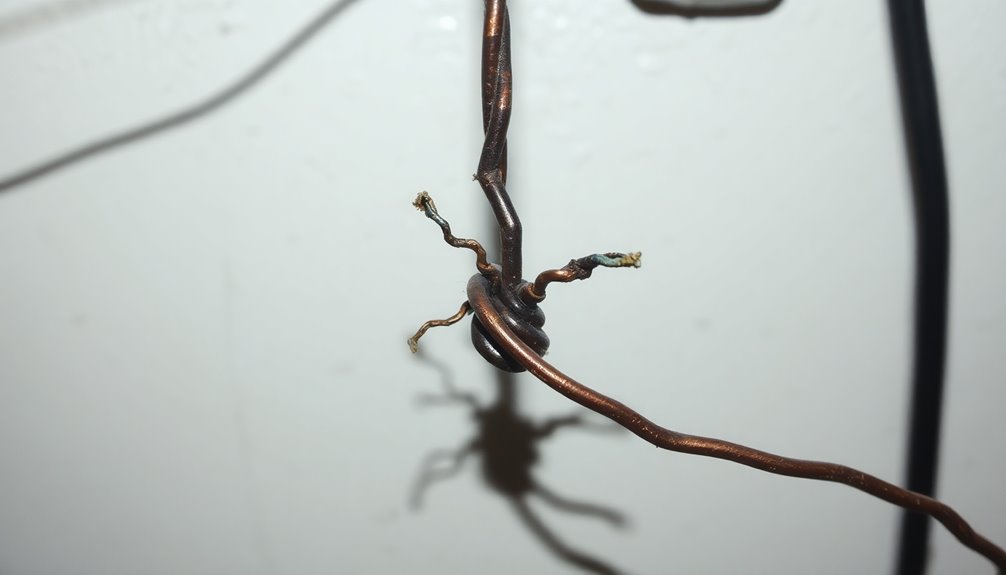
Dealing with frayed wires requires prompt attention to secure safety and functionality. Ignoring these hazards can lead to severe consequences, including electrical fires or electrocution.
Here are some effective repair and replacement options:
- Electrical Tape: While it offers a temporary fix for frayed wires, don't rely on it for long-term safety. It can degrade over time and may not withstand high temperatures.
- Heat Shrink Tubing: This method seals and insulates damaged wires effectively. When heated, the tubing contracts around the frayed area, providing a secure barrier against moisture and wear.
- Professional Assessment: For extensive damage or uncertainty about repair methods, always consult a licensed electrician. They secure compliance with safety regulations and proper handling of electrical systems.
If you find that the damage is severe, complete replacement of the frayed wires is essential. This eliminates the risk of electrical fires and secures your home remains safe.
Additionally, consider using cable protectors to prevent future fraying from surface friction. By taking these steps, you can effectively address the hazards facing your electrical systems.
Preventive Measures for Safety
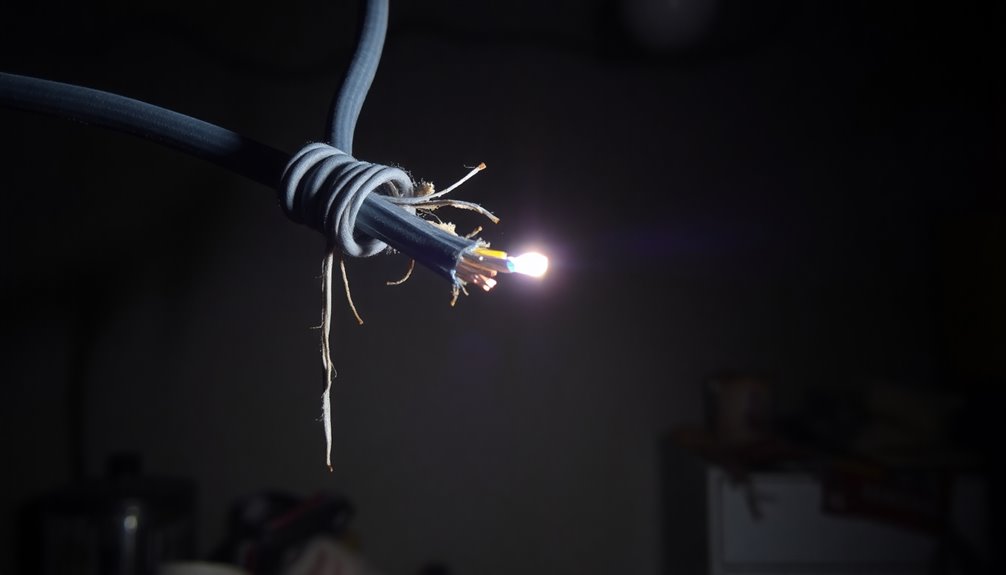
Taking proactive steps can greatly reduce the risk of frayed wires and the hazards they pose. Implementing preventive measures is essential for guaranteeing electrical safety in your home.
Start by scheduling regular electrical inspections; these can help identify frayed wires early, considerably lowering your chances of an electrical fire. Remember, electrical faults contribute to approximately 3,000 house fires annually, so don't take this lightly.
Use protective coverings and cable management solutions to shield your wires from environmental damage and physical abrasion. Proper installation techniques can also prevent strain on wires, which is a common cause of fraying.
Educate everyone in your household about the signs of frayed wiring; this knowledge can empower them to act quickly. Additionally, monitoring financial accounts for unusual activity can help prevent the costly repercussions of electrical issues.
If you notice any frayed wires, turn off the power immediately and contact a professional for repairs. Addressing fraying promptly can prevent costly damages and mitigate severe injury risks from electrical hazards.
Taking these steps not only protects your home but also guarantees the safety of everyone living in it. Prioritize these measures to maintain a safe environment free from the dangers associated with frayed wires.
Frequently Asked Questions
What Does Frayed Wire Mean?
Frayed wire refers to electrical wiring that's become damaged, exposing the conductive metal inside. This exposure can lead to serious risks like short circuits, electrocution, or even fires.
You might notice signs like visible damage, flickering lights, or unusual smells. If you see these signs, it's essential to act quickly.
Regularly inspecting your wiring can help you catch frayed wires early, preventing potential hazards from escalating into dangerous situations.
Stay safe!
What Type of Hazard Are Frayed Wires?
Frayed wires symbolize hidden danger lurking in your home, like shadows creeping across a room.
These hazards can spark electrical malfunctions, leading to short circuits that threaten your devices and safety. The risk of fires looms large, with statistics showing thousands of incidents each year.
You've gotta stay vigilant; regular inspections can catch these issues early, keeping your space safe and sound.
Don't let frayed wires turn your sanctuary into a perilous place!
What Should You Do if You Find a Frayed Wire?
If you find a frayed wire, the first thing you should do is disconnect the power supply immediately to avoid any electrical hazards.
Assess the damage; if it looks severe, replace it instead of trying to repair it. You can use electrical tape or heat shrink tubing as a temporary fix, but don't rely on that long-term.
Regularly inspect your wiring to catch issues early, and consult a licensed electrician if you're unsure.
What Can Frayed Wires Cause?
Frayed wires pose perilous problems, potentially causing significant safety and financial issues.
They can spark short circuits, leading to costly repairs and possible property damage. Their exposed nature heightens the hazard of electrocution, delivering dangerous shocks to anyone nearby.
Beyond personal safety, frayed wires may disrupt daily routines, triggering unexpected system downtime.
In short, ignoring frayed wires invites a host of harmful consequences that can jeopardize your home and well-being.
Conclusion
In the end, don't let frayed wires lurk in your home like a silent predator. By staying vigilant and knowing the signs of damage, you can protect your loved ones from potential disasters. Remember, a simple inspection can be the difference between safety and a shocking experience. Take action now—repair or replace damaged wiring, and embrace preventive measures. Your home should be a sanctuary, not a ticking time bomb waiting to explode. Stay safe!
